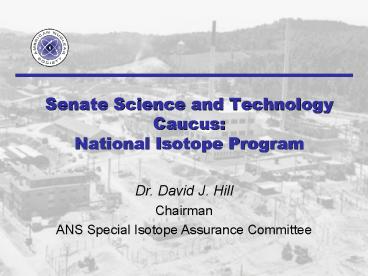Senate Science and Technology Caucus: National Isotope Program PowerPoint PPT Presentation
1 / 8
Title: Senate Science and Technology Caucus: National Isotope Program
1
Senate Science and Technology CaucusNational
Isotope Program
Dr. David J. Hill Chairman ANS Special Isotope
Assurance Committee
2
American Nuclear Society
- The American Nuclear Society (ANS) is a
not-for-profit, international, scientific and
educational organization composed of
approximately 10,500 engineers, scientists,
administrators, and educators representing 1,600
plus corporations, educational institutions, and
government agencies - The ANS serves to develop and safely apply
nuclear science and technology for public benefit
through knowledge exchange professional
development, and enhanced public understanding - The ANS Special Committee on Isotope Assurance
was established to develop a Corridor of Action
to ensure an isotope supply
Members of the ANS Special Committee
on Isotope Assurance (2003-2004) (Parentheses
denote the organization represented by the
individual) David J. Hill, Chair Jeanne K.
Krieger Oak Ridge National Laboratory
Bristol-Myers Squibb Medical Imaging Brad
Patton, Vice Chair Council on Radionuclides
and Oak Ridge National Laboratory
Radiopharmaceuticals CORAR) Leo Bobek James
Muckerheide University of Massachusetts,
Lowell Worcester Polytechnic Institute (ANS
Isotopes and Radiation Division) (ANS Biology
and Medicine Division) Ralph A. Butler Mark J.
Rivard University of Missouri Research
Tufts-New England Medical Center Reactor
Center Edward (Ted) B. Silberstein Marc Garland
University of Cincinnati College of University
of South Carolina Medicine (Society of Nuclear
Medicine)
3
Extensive Facilities Needed for Isotope Production
Nuclear reactor or accelerators to produce
isotopes
Isotope enrichment facilities for highly enriched
isotopes for targets
Laboratories for developing radiopharmaceuticals
Hot cells to purify for use
4
Historical Government Role
- First radioisotope made available from Oak Ridge
National Laboratory in 1946 - Isotope research and development is mandated in
the Atomic Energy Act of 1954 - Majority of large nuclear facilities and nuclear
and radiochemical expertise reside within DOE and
its laboratories - Successful history of major radioisotopes for
nuclear medicine including (most developed in the
DOE laboratories) - Tc-99m, the most important diagnostic
radioisotope - Tl-201, the standard for heart scans
- I-131, for thyroid imaging and therapy
- F-18, for PET imaging for cancer and brain
functions - Y-90, for cancer therapy
- Ga-67, for tumor imaging
5
Development of Radiopharmaceuticals is an 8-10
year Process
Approved for use
Submission, Review and Approval of New Drug
Application to FDA
Set-up and running of FDA approved manufacturing
facility
Phase I, II, and III Clinical Studies
Animal Studies -Proof of principal, toxicity
studies, etc.
Concept to initial chemical development
8-10 years
- Investment - 50-200 million/new
radiopharmaceutical only two new
radiopharmaceuticals recently approved
6
Summary of Issues Arising From Current Isotope
Situation in the United States
- Dependence on foreign suppliers in situations
where impacts of supply interruptions are
unacceptable is not being systematically
addressed - Reasonably priced RD isotopes are not available
due to declining resources and policy changes in
the DOE Isotope Program - Elimination of DOE RD funding is impacting
development of future isotope applications and
limiting U.S. isotope business development - Limited national isotope production resources are
not being coordinated to effectively meet the
needs of the country - Lack of infrastructure support for aging
production facilities and failure to develop
long-term plans for facility replacement have
resulted in a loss of capability to produce
isotopes to a critical level - Decline in nuclear and radiochemistry education
is not being addressed to avoid detrimental
impacts on radioisotope production and
applications RD
7
Recommendations
- Establish a new national isotope policy and
develop a long-term strategic plan - Establish a national isotope program organization
to implement the national isotope policy and
long-term strategic plan - Establish an independent scientific advisory
board for the national isotope program to provide
oversight and guidance for the program director - Ensure that the national isotope program office
is adequately staffed - Promote technology transfer to the private sector
- Ensure adequate resource allocation to support
the programs
8
Functions of a National Isotope Program

